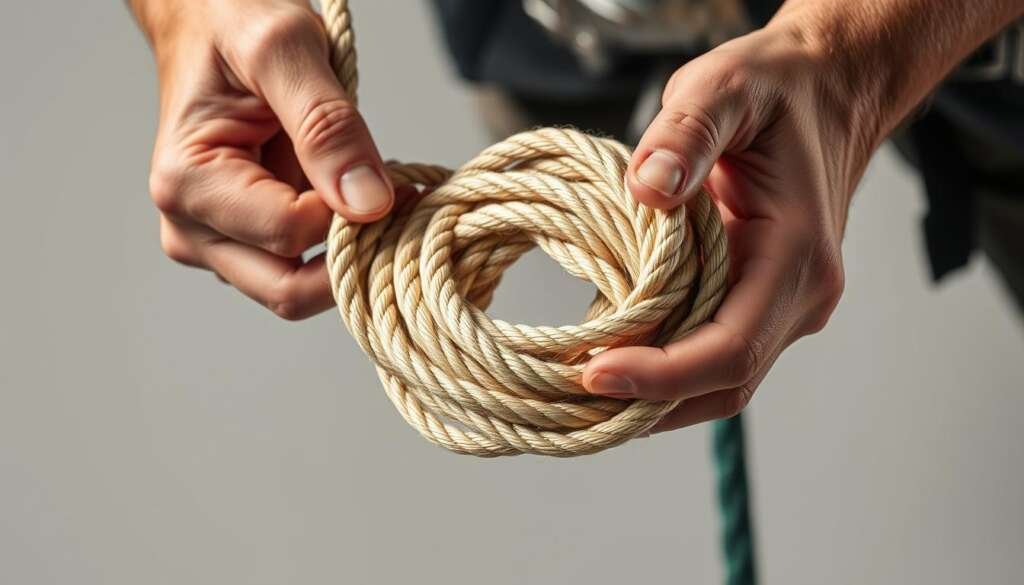Welcome to your new approach to equipment care! Whether you’re scaling granite walls or tackling indoor routes, your climbing gear works hard. Dirt and wear don’t just look bad—they impact performance. A single muddy adventure can weaken ropes by 20%, and repeated use without cleaning might slash their strength in half.
We’ve all been there: untangling knotted ropes or dealing with stiff carabiners. Proper maintenance isn’t about perfection—it’s about safety and saving money. Research shows well-cared-for equipment lasts 4-5 years with occasional use, compared to just one year if neglected.
This guide breaks down the process into simple steps. You’ll learn to revive smelly shoes, store harnesses correctly, and spot when gear needs retirement. Best part? A few hours of care annually can add years to your kit’s lifespan.
Key Takeaways
- Dirt reduces rope strength by up to 40% after repeated exposure
- Proper care extends gear lifespan from 1 year to 4-5 years
- Basic maintenance takes only 2-3 evenings annually
- Common issues like odor and stiffness are easily preventable
- Storage methods impact equipment longevity as much as cleaning
Preparing Your Gear for a Thorough Clean
Ever spent 45 minutes wrestling with a tangled rope? Proper prep work saves time and prevents damage. Start by setting up a dedicated workspace—a clean kitchen counter or garage table works perfectly.
Mastering Rope Uncoiling
New ropes arrive coiled like sleeping snakes. Yanking them creates instant knots. Instead, try the macarena method:
- Slide both arms through the rope’s center loop
- Rotate your body in wide circles while a partner pulls gently
- Maintain steady tension to prevent twists
Essential Cleaning Toolkit
Gather these supplies before starting:
- Dawn dish soap (cuts grease without harsh chemicals)
- Plastic tub or clean sink for washing
- Soft-bristle brush for stubborn dirt
- Dish rack or towel-lined surface for drying
Stiff carabiners? Soak them in warm soapy water. For smelly shoes, use a 1:3 vinegar solution. Always work in a well-ventilated area, and never mix cleaning products. With your materials ready, you’ll breeze through the actual washing phase.
Mastering the Basics: How to Clean and Maintain Your Climbing Gear
Your equipment deserves more than a quick rinse. Proper techniques preserve strength and prevent premature wear. Let’s transform grimy ropes and sticky hardware into reliable partners for your next ascent.

Step-by-Step Rope Cleaning Techniques
Start with a bathtub filled with lukewarm water—hot temperatures weaken fibers. Submerge the climbing rope completely, gently massaging to loosen embedded dirt. “Plunge it like you’re making pasta,” suggests veteran climber Jenna Liu. “Three minutes of agitation removes 80% of debris.”
For heavily soiled ropes, front-loading washing machines work wonders. Run an empty cycle first to flush leftover detergent. Daisy-chain the rope using locking carabiners to prevent tangles. Use cold water and soap specifically designed for technical fabrics.
Washing and Air-Drying Methods
After washing, hang ropes over padded surfaces—never metal hooks. Air dry in shaded areas with good airflow. Direct sunlight and heat degrade nylon over time. Harnesses and slings dry fastest when laid flat on mesh racks.
Safe Procedures for Cleaning Carabiners and Cams
Submerge carabiners in warm soapy water, squeezing springs to dislodge grit. Rinse thoroughly, then dry with microfiber cloths. Apply bicycle chain lube sparingly to pivot points once fully dry. Wipe excess to avoid attracting new dirt.
For cams, work soap into lobes while opening and closing mechanisms. Rinse until water runs clear—cloudy liquid means hidden debris remains. Store cleaned gear in breathable bags until your next adventure.
Pro Tips for Storage and Advanced Gear Maintenance
Your rope’s worst enemies? Sunlight and bad coils. Smart storage solutions prevent UV damage while keeping gear ready for action. Let’s explore techniques that protect investments and simplify pre-climb prep.
Coiling Mastery & Bag Essentials
Ditch the frustration of tangled lines with the shoulder-drape method:
- Grab both rope ends in your dominant hand
- Drape arm-length loops over alternate shoulders
- Secure the bundle with remaining line using a figure-eight finish
Top-performing bags combine durability with clever features:
| Model | Price | Key Benefit |
|---|---|---|
| Blue Ice Koala | $43 | Stop markers for 80m ropes |
| Kavu Shapiro | $55 | Removable tarp system |
| Mammut Magic | $68 | Triple-use design |
Inspection Routines & Quick Fixes
Weekly checks catch issues early. Look for:
- Fuzzy areas (more than 1mm height)
- Flat spots from rock abrasion
- White core exposure – “If you see white, retire it right”
Ropes naturally shrink 2-3% after initial use. Veteran climber Alex Honnold notes: “I log every inspection – it reveals wear patterns over years.” For minor sheath damage:
- Trim frayed fibers with nail clippers
- Seal ends with a lighter (brief blue flame)
- Mark changes with chalk or fabric pen
Field-smart habits matter. Keep gear away from cliff edges and curious pets – dog urine’s acidity weakens fibers faster than water exposure. Store in breathable bags between gym sessions to prevent mildew.
Conclusion
Your climbing adventures deserve reliable partners – let’s keep them in peak shape. Regular care transforms worn equipment into trusted tools, whether you’re tackling granite faces or indoor walls. Remember: a few hours each year prevents 80% of premature wear.
Stick to the essentials. Wash ropes in cool water, lubricate carabiners sparingly, and store gear away from sun damage. Proper drying techniques and breathable bags fight mildew better than any fancy products. Inspect materials monthly – fuzzy ropes or stiff cams tell stories of past climbs.
Retirement timelines matter. Frequent climbers should replace shoes yearly, while occasional users gain 4-5 years from their kit. When gear ages out, get creative: old ropes become dog leashes or rock-inspired art.
Grab your cloth and guide – it’s time to prep for safer sends. With fresh gear and smart habits, your next day at the crag will feel like meeting old friends ready for new challenges.

